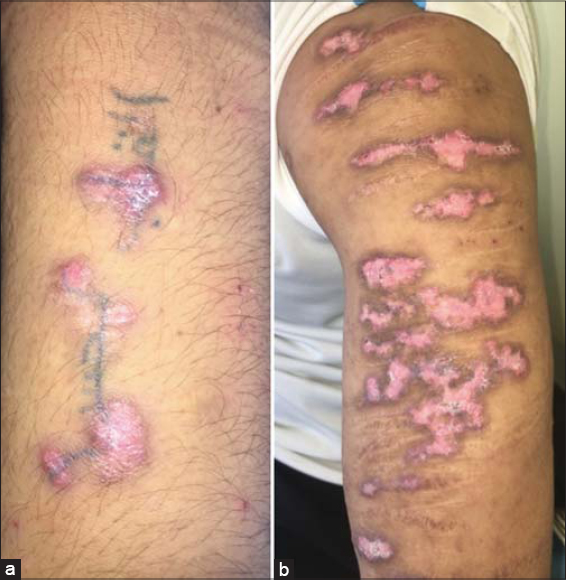Koebner’s phenomenon: Discoid lupus on scars and tattoo
Chaymae Jroundi , Sara Elloudi, Jihad Kassel, Zakia Douhi, Hanane Baybay, Fatima Zahra Mernissi
, Sara Elloudi, Jihad Kassel, Zakia Douhi, Hanane Baybay, Fatima Zahra Mernissi
Department of Dermatology, University Hospital Hassan II, Fes, Morocco
Corresponding author: Chaymae Jroundi, MD
How to cite this article: Jroundi C, Elloudi S, Kassel J, Douhi Z, Baybay H, Mernissi FZ. Koebner’s phenomenon: Discoid lupus on scars and tattoo. Our Dermatol Online. 2022;13(e):e7.
Submission: 10.09.2021; Acceptance: 04.01.2022
DOI:10.7241/ourd.2022e.7
Citation tools:
Copyright information
© Our Dermatology Online 2022. No commercial re-use. See rights and permissions. Published by Our Dermatology Online.
Sir,
Koebner’s phenomenon, also called “isomorphic response” refers to inflammatory skin lesions induced by skin trauma. It occurs in several dermatological conditions, most commonly psoriasis, vitiligo and lichen planus. This phenomenon has been further reported in various systemic diseases [1]. It is one example of an immunocompromised district (ICD), defined by Ruocco in 2014 as areas of the skin with an immune microenvironment conducive to the development of a new disease. Lesions of discoid lupus are often photo-distributed because photosensitivity may play an important role in the pathogenesis of cutaneous lupus erythematosus. Few cases of Koebner’s phenomenon occurring in patients with lupus erythematosus have been described [2]. In these reports, lupus skin lesions occurred in response to contact dermatitis, tattoos, herpes zoster, and surgical scars as well as to minimal stimuli, such as scratches or pressure from tight clothing [3]. Regarding its pathophysiology, it has been hypothesized that two stages may be essential in the occurrence of the Koebner phenomenon. In the first step, different environmental stimuli induce the production of several cytokines such as IL-1, TNF-a, IL-6, IL-8, INFg. The second stage is a disease-specific response implicating auto antibodies or specific receptors [1,4].
We report a case of Koebner’s phenomenon in a patient with discoid lupus lesion occuring in both scars and tattoos.
A 29-year-old patient, with a history of discoid lupus erythematosus (DLE) evolving for 2 years. He presented in our department for an extension of the cutaneous lesions. He was also treated for depression with antidepressants following several suicide attempts and self-mutilation. The dermatological examination revealed erythematous and squamous plaques with an atrophic center on the trunk and limbs linearly-arranged along old mutilation scars. (Fig. 1). Other lesions were present on the nose and the concha. Patches of lupus were also noted reproducing the shape of a recent tattoo on the forearm. Dermoscopy showed: white scales; follicular keratotic plugs; linear vessels; peripheral pigmentation and blue pigment on lesions overlying the tattoo (Fig. 2). At the end of the examination, it was concluded that the disease had worsened as a result of Koebner’s phenomenon. The patient was educated on the importance of avoiding any type of skin trauma and was treated with highly potent topical corticosteroids and hydroquinone with regular psychiatric follow-up.
Consent
The examination of the patient was conducted according to the principles of the Declaration of Helsinki.
The authors certify that they have obtained all appropriate patient consent forms, in which the patients gave their consent for images and other clinical information to be included in the journal. The patients understand that their names and initials will not be published and due effort will be made to conceal their identity, but that anonymity cannot be guaranteed.
REFERENCES
1. Ueki H. Koebner phenomenon in lupus erythematosus with special consideration of clinical findings. Autoimmun Rev. 2005;4:219-23.
2. Kushwaha RK, Mohta A, Jain SK. Atypical presentations of superficial dermatophytoses associated with Ruocco’s immunocompromised cutaneous district:A case series. Our Dermatol Online. 2021;12:406-11.
3. Yamamoto T. Köbner phenomenon in systemic lupus erythematosus. Our Dermatol Online. 2019;10:101-2.
4. Kluger N, Andraud M, Lartigau-Roussin C, Sultan-Bichat N. The Koebner phenomenon on tattoos and piercings in a patient with cutaneous lupus:a case report and review of the literature. Acta Dermatovenerol Alp Pannonica Adriat. 2021;30:43-6.
Notes
Source of Support: Nil,
Conflict of Interest: None declared.
Request permissions
If you wish to reuse any or all of this article please use the e-mail (brzezoo77@yahoo.com) to contact with publisher.
| Related Articles | Search Authors in |
|
 http://orcid.org/0000-0002-5942-441X http://orcid.org/0000-0002-5942-441X http://orcid.org/0000-0002-5942-441X http://orcid.org/0000-0002-5942-441X |





Comments are closed.